RISD, facilities workers ratify contract
 BY ASHLEY CAI SENIOR STAFF WRITER
BY ASHLEY CAI SENIOR STAFF WRITER
The Teamsters Local 251 union representing the Rhode Island school of Design’s 62 custodians, groundskeepers and movers unanimously voted to ratify a six-year contract with annual wage increases Tuesday afternoon, according to union representatives and an email to the school community from RIsD president Crystal Williams.
The new six-year contract retroactively begins on July 1, 2022, leaving five years remaining on the agreement, according to Local 251 Business Agent Tony s uazo.
This agreement was preceded by an indefinite strike and picket line that began April 3. Representatives from the union and RI s D first met April 13 to discuss a potential proposal and reached the tentative agreement Monday, The Herald pre
UNIVERSITY NEWS
viously reported.
Wages were the main emphasis of the demonstrations in the past few weeks, as the average hourly pay rate for union members was $16.74, according to s uazo. The ratification of the contract immediately raises the average rate of current employees to roughly $19.40, according to s uazo, and wages will continue to increase to a minimum of $20.20 for workers who have been employed at RI s D for at least 12 months in July 2023.
Looking at gender diversity in student government
Current and former sGA members discuss gender diversity progress, challenges
BY KATHY WANG UNIVERSITY NEWS EDITOR
In fall 2020, the Undergraduate Finance Board had seven female and four male students on their board. Today, it only has two female members.
In contrast, multiple Class Coordinating Boards have been led by women in recent years. But s onia s achar ’20, 2019 CCB co-president, said that CCB has historically been “a little bit less diverse” due to its relationship with Greek life.
To delve into the current and past gender breakdowns of student government at Brown, The Herald examined past coverage and emails from current and former s tudent Government Association leadership and talked to members of all three s GA branches — UFB, CCB and the Undergraduate Council of s tudents.
UFB: Searching for gender diversity
As UCs chair of student activities who also sits on UFB, Will Borges ’24 is the only current member of UFB who served on the 2020-21 board other than current Chair Amienne s pencer-Blume ’23 — the first female chair since the 2018-19 academic year.
s pencer-Blume declined a request for comment.
The 2020-21 board was “very cool to be a part of,” Borges said adding that “there were a lot of great conversations” over Zoom.
But many female members on the board that year did not run again, Borges said. Female membership in UFB drastically decreased from 2020-21 to 2021-22 — from 7 to 3 — and the number has decreased since.
Two of the board’s rising seniors — Gianna DeVincenzo ’22 and Claire Brown ’22 — both ran for re-election in 2021, with DeVincenzo elected as at-large representative and Brown as vice chair. The only other female member of UFB coming into
SEE GENDER PAGE 3
Wages will increase annually through the end of the contract, and the agreement includes retroactive payments to workers at their current rate going back to October of last year.
The contract also includes parity language in its last two years, meaning that if other staff at RI s D receive a raise larger than 2%, facilities workers will receive a raise at the same
SEE RISD PAGE 2
UNIVERSITY NEWS
Smiley talks voluntary payments, housing
METRO Brown Dems hosts discussion focused on Brown, providence relationship
BY SAM LEVINE UNIVERSITY NEWS EDITOR
providence Mayor Brett smiley discussed ongoing negotiations of Brown and other non-profit institutions’ voluntary payments in lieu of taxes, the city’s housing crisis and public safety in a moderated conversation in stephen Robert ’62 Hall Tuesday evening.
The event — organized by the Brown College Democrats and sponsored by the Brown political Review and the Taubman Center for American politics and policy — aimed to provide Brown community members and providence residents an opportunity “to hear directly from the mayor about his vision for the future of providence and the role Brown can play in creating a better providence,” according to the Taubman Center’s
event page.
The conversation was moderated by Brown Dems Vice president Noah Rosenfeld ’24 and began with a discussion of the renegotiation of the University and the city’s voluntary payments agreements, which will expire this June. Brown, the Rhode Island school of Design and other non-profit institutions in Providence do not pay property taxes, instead paying a fraction of what they would pay in taxes to the city through a 2003 memorandum of understanding and a 2012 memorandum of agreement. smiley said that the push to increase revenue from tax-exempt institutions has been a “major issue” for his administration, adding that his office is trying to “reimagine and reframe the debate” around the payment agreements. While he noted that Brown and other institutions “should be paying more,” smiley also acknowledged that they are essential to the “vitality” of the city.
In addition to renegotiating these
SEE SMILEY PAGE 8
Brown’s Corporation, by the numbers
BY NEIL MEHTA & CHARLIE CLYNES UNIVERSITY NEWS EDITORS

In 1764, under the Charter of the University, the Corporation was formed.
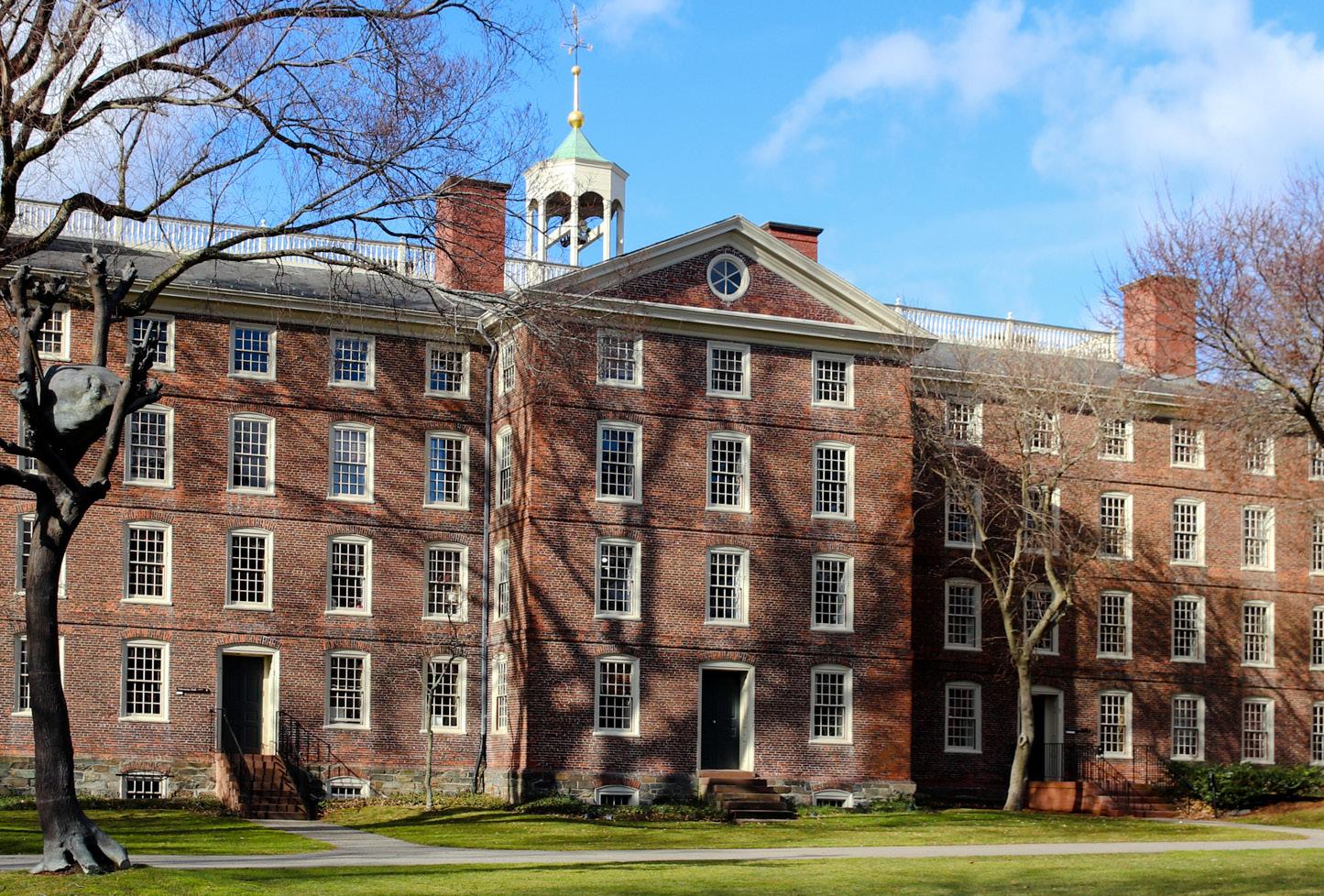
The Corporation is a “bicameral” body that is “composed of a Board of Trustees and Board of Fellows,” then-president Henry Wriston explained in 1946. Tasked with the governance of the University, the Corporation “constitutes an extraordinary precaution against hasty or drastic action,” he wrote.

Today, the Corporation stands as the University’s chief body of governance. It selects the president and sites for buildings, and it determines the University budget and student tuition. Though not involved in day-to-day administrative decisions, the Corporation holds significant influence over the University’s finances and long-term strategy.
Using University records, government databases and other publicly available information, The Herald compiled a profile of the University’s highest governing
body — its members’ education, political activity and their roles in Brown’s governance.
How the Corporation is structured
Today, the Corporation comprises 12 fellows and 42 trustees, including president Christina paxson p’19 p’MD’20, Chancellor samuel Mencoff ’78 p’11 p’15 and Vice Chancellor pamela Reeves ’87.
The Corporation internally elects all fellows and 27 trustees for 11- and six-year terms, respectively, with fellows limited to one term. 13 trustees are elected through an agreement between
the Corporation and the Brown Alumni Association, and the remaining two are “new alumni trustees” chosen by students in their final year of study. “Members of the Corporation are chosen for their commitment to the University and its mission of education and research,” according to the Corporation’s website.
Brown’s Charter assigns additional responsibilities to fellows, including “the instruction and immediate (governance) of the College” and “adjudging and conferring … academical degrees.” Fellows
SEE CORPORATION PAGE 7

THE BROWN DAILY HERALD BROWNDAILYHERALD.COM SINCE 1891 W EDNE s DAY, Ap RIL 19, 2023 Brown Athletics publishes Strategic Plan detailing goals Page 2 students, staff discuss nutrition at Brown’s dining halls Page 4 Committee recommends holding 27 gun bills for further study Page 5 Sports U.News Metro 40 / 56 38 / 68 TODAY TOMORROW Women’s crew team places first in 12 of 14 Ivy League Invitational races Page 8 Sports DESIGNED BY TOM LI ’26 DESIGNER MENASHA LEPORT ’25 DESIGNER NATHANIEL SCOTT ’24 DESIGNER GRAY MARTENS ’25 DESIGN EDITOR VOLUME CLVIII, IssUE 33
-
UNIVERSITY
NEWS
six-year contract goes into effect immediately, retroactive to July 1, 2022
Exploring the makeup, background, political activity of the Corporation’s members
HERALD FILE PHOTO
Full Corporation meetings occur three times each year, taking place in February, May and October, though fellows meet more often.
JAKE SREBNICK / HERALD
Wages will increase annually through the end of the contract, and the agreement includes retroactive payments to workers.
SPORTS
Brown announces strategic plan for Division of Athletics and Recreation
Plan identifies five strategic priorities, aims to benefit both athletes, non-athletes
BY SOFIA BARNETT & LINUS LAWRENCE UNIVERSITY NEWS EDITOR & SPORTS EDITOR
On March 10, Brown Athletics published its “Division of Athletics and Recreation s trategic p lan,” a vision that Vice p resident for Athletics and Recreation M. Grace Calhoun ’92 p hD p ’26 p ’26 called a “promotion of (Brown’s) open curriculum concept” in University athletics.
The plan identifies five strategic priorities: competing with distinction, broad participation supporting campus wellness, growth through holistic development and sport performance, community engagement and investments in community members through infrastructure and resource optimization.
Calhoun, who arrived at Brown in March 2021, said the plan has been in development since her earliest conversations with p resident Christina p axson p ’19 p ’MD’20.
“There was a lot of outreach to me with perspectives. … (I was) just getting a broad sense of where things were and what people would like to see going forward,” Calhoun said. “Once we established (a shared vision), we could start talking about the pieces to get to that shared vision.”
The strategic plan’s first priority centers around striving for excellence in varsity and club sports. The plan lays out a variety of benchmarks for success, including finishing in the top half of the Ivy League for cumulative varsity championship wins.
“I sometimes say I’m probably the second-most competitive person on campus, the first one being the p resident,” Calhoun said. “We’ve put a five-year timeline on most of (these benchmarks), knowing that we’re building it for sustained success.”
In the case of earlier successes, “we’re gonna build more aggressive goals,” and where success lags, “we will go back and reassess” the plan, Calhoun said. “It’s gonna be this living, breathing document that constantly gets better.”
The first priority also emphasizes the importance of recruitment in the success of varsity teams, including data analysis to better evaluate trends in prospective students and alums. The “true measure of success” is bringing in students that will thrive both at Brown and beyond, “leading lives of impact and fulfillment,” Calhoun said.
While Calhoun emphasized the value of strong on-field performance, she also noted the importance of fostering increased participation supporting campus wellness — the plan’s
RISD FROM PAGE 1
rate, according to s uazo. Employees who have been with RI s D for more than 20 years will also receive a yearly longevity bonus.
Workers will return to work on Wednesday, according to s uazo.
second strategic priority.
On the plan’s second priority, Calhoun said she hopes to “enhance the Brown experience to make it as meaningful as possible,” regardless of a student’s level of athletic participation. p art of this effort includes supporting greater conversations around nutrition, sleep recovery and mindfulness while also promoting the numerous existing programs and classes available to students seeking out athletic opportunities at Brown, including workout classes at the Nelson Fitness Center and intramural sports, she added.
Assistant Vice p resident for Athletics and Recreation/Governance and performance s hoshanna Engel Lewis said that the plan’s focus on strengthening personal holistic development and sport performance — the third strategic priority — is “interdisciplinary.”
Engel Lewis explained that the plan’s developers recognized that “there wasn’t necessarily a strategy to inform the lifecycle of wellness and performance from the time athletes were recruited until they graduate and beyond.”
After recognizing the need for a “stronger care model on the medical side” for varsity student-athletes, Engel Lewis said that the Athletics team
s uazo and John Cabral, a RI s D grounds caretaker, emphasized the significance of student, staff and community support as they went through contract negotiations.
This contract “would have never happened without the support from this community, especially the stu -
“worked really closely with Health s ervices on the nutrition side, and (Counseling and p sychological s ervices) on the mental health side.”
This collaboration resulted in the creation of two new full-time positions for staff that would support varsity student-athletes: a sports dietitian and a sports psychologist, The Herald previously reported.
Engel Lewis hopes these new additions will provide access to professionals who “really understand Brown and also the experience of a Brown student-athlete” while strengthening partnerships with other campus partners and recognizing underutilized resources like the Mindfulness Center.
“We really thought, if this could come to life as an ecosystem — something that is continual collaboration — what we could accomplish is so distinctively Brown,” Engel Lewis added.
The plan’s fourth strategic priority highlights community engagement, both in person and on social media.
“ s ocial media for us is not necessarily the business-like button-down approach, it’s supposed to be fun,” said Kelvin Queliz, associate director of athletics, strategic communications and content creation. “It’s not necessarily just, here’s a score, here’s
dents. They really came through for us,” Cabral previously told The Herald. “This was as much of a victory for them as for us, and we’ll never forget that.”
“There were some folks within the university that underestimated the will of the workers and the power of
a graphic, that’s it. How are we telling a unique story?”
“We’re trying to create experiences that become these goosebump, you’ll-never-forget experiences, because you’re with your fellow students supporting your school (and) having a great time,” Calhoun said.
Calhoun noted the importance of students in creating new traditions for Bears sports, highlighting the Brown Hype s quad, an organization founded by student-athletes with help from the Athletics Department.
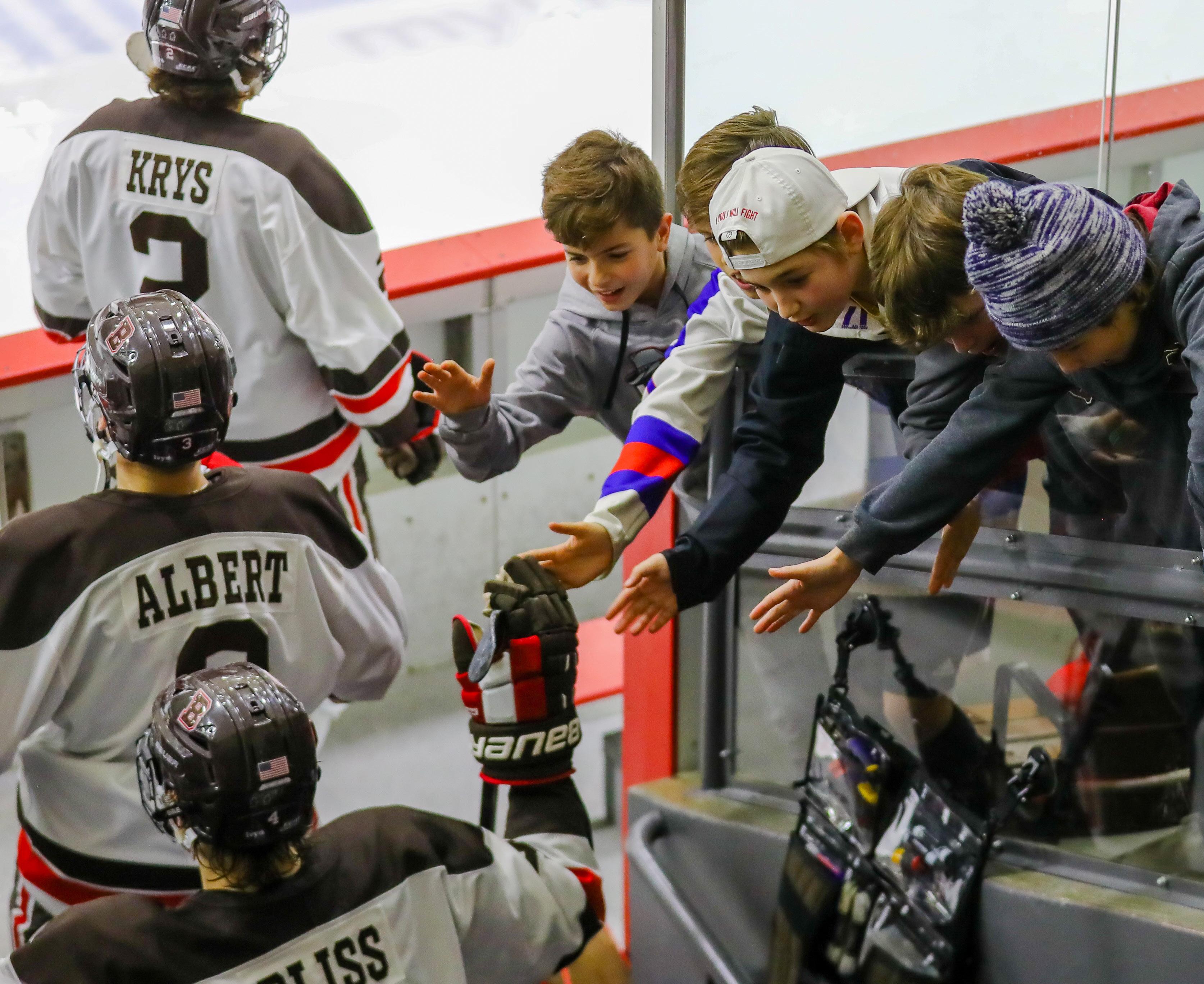
The plan also touches on efforts to engage with the p rovidence community as a whole. One such initiative is Bruno’s Cub Club, announced last summer, which gives kids in 6th grade and under free tickets to a regular season game, a t-shirt and a birthday card.
“We want to get as many local youth as possible to feel like the Brown events are for them,” Calhoun said.
According to Calhoun, the plan’s fifth strategic priority to optimize athletic resources and infrastructure has the potential to “erase the divide between student-athletes and non-athletes.”
“Everyone should be an athlete on some level, just like everyone should be an artist on some level,” she said.
the students,” s uazo said.
RI s D is now taking on the initiative to “increase wages for all of our non-temporary employees who make less than $17.52 per hour,” according to an April 13 email from Williams.
The administration will “soon begin speaking with the most impacted
“The beauty of Brown is that you can try a bit of everything … but everyone should feel included and welcome to try things.”
“I think it’s fair to say that students are more involved now than ever,” Calhoun continued. “But because we still want more to get involved, we know we’re going to have to address space concerns.”
Calhoun pointed to the Nelson Center renovations as an example of Brown Athletics “trying to use the space better to be able to accommodate more people effectively at once.” s he also noted the development of the Nelson’s occupancy tracker which helps patrons better plan their workout windows and avoid the gym’s busier hours.
Calhoun also hopes to “take one of the classroom spaces (at the Nelson) and build it out with more weights” to create a “specialized room for people who might be new to weightlifting” to feel comfortable in that setting.
All five strategic priorities identified in the plan “work together,” Calhoun said.
“ s o while I think, as the athletic director, that peers of mine might say competitive success is the most important thing, I look at this and say all five goals work together,” she added. “We need success in all areas.”
departments,” Williams wrote in the most recent email.
Additionally, Williams plans to convene “an advisory group to recommend immediate steps to help address and repair the fissures that the events of the last two weeks deepened and/or created.”
2 W EDNE s DAY, Ap RIL 19, 2023 THE BROWN DAILY HERALD | NEWS
COURTESY OF CHIP DELORENZO / BROWN ATHLETICS
Vice President for Athletics and Recreation M. Grace Calhoun Ph.D’92 P’26 P’26 said the plan has been in development since her earliest conversations with President Christina Paxson P’19 P’MD’20.
fall 2021 was s pencer-Blume, an atlarge representative and a junior at the time.
But a series of resignations and special elections brought the total number of women on UFB down to one by the spring.
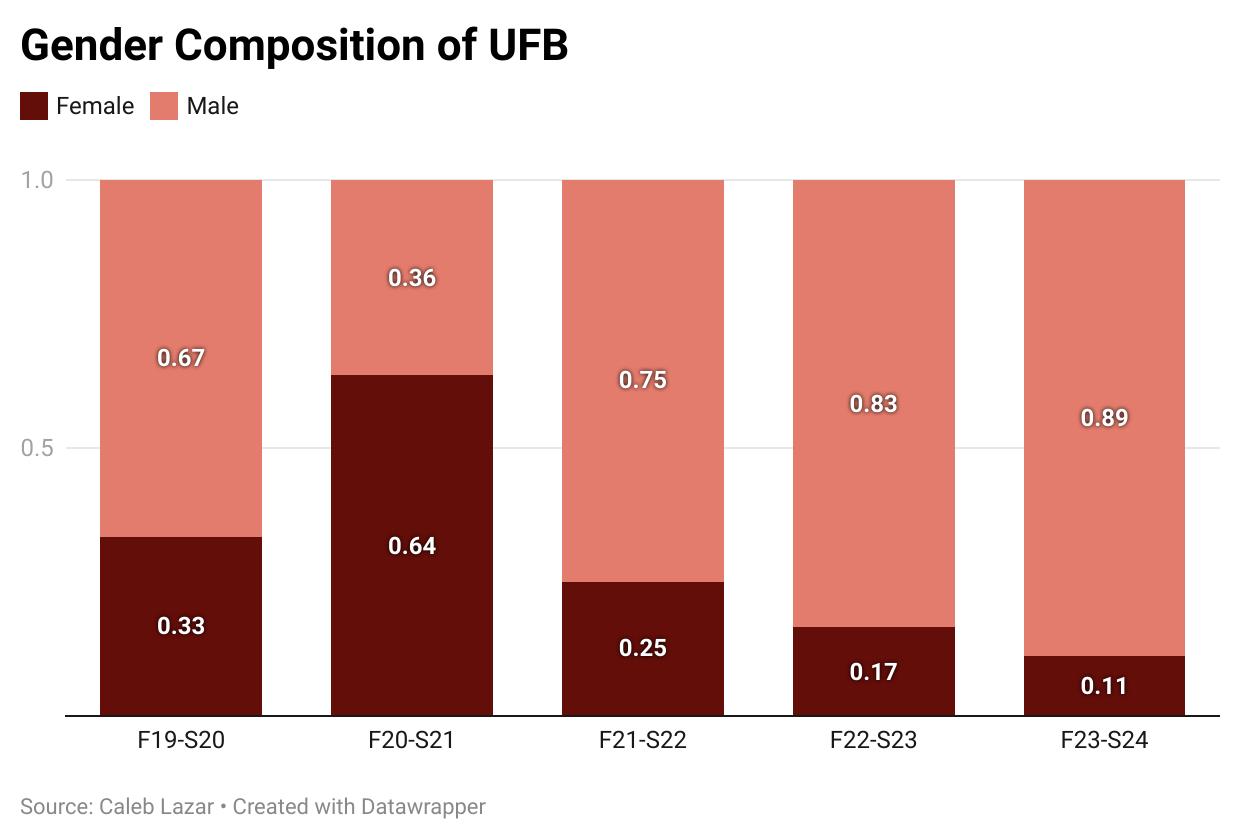
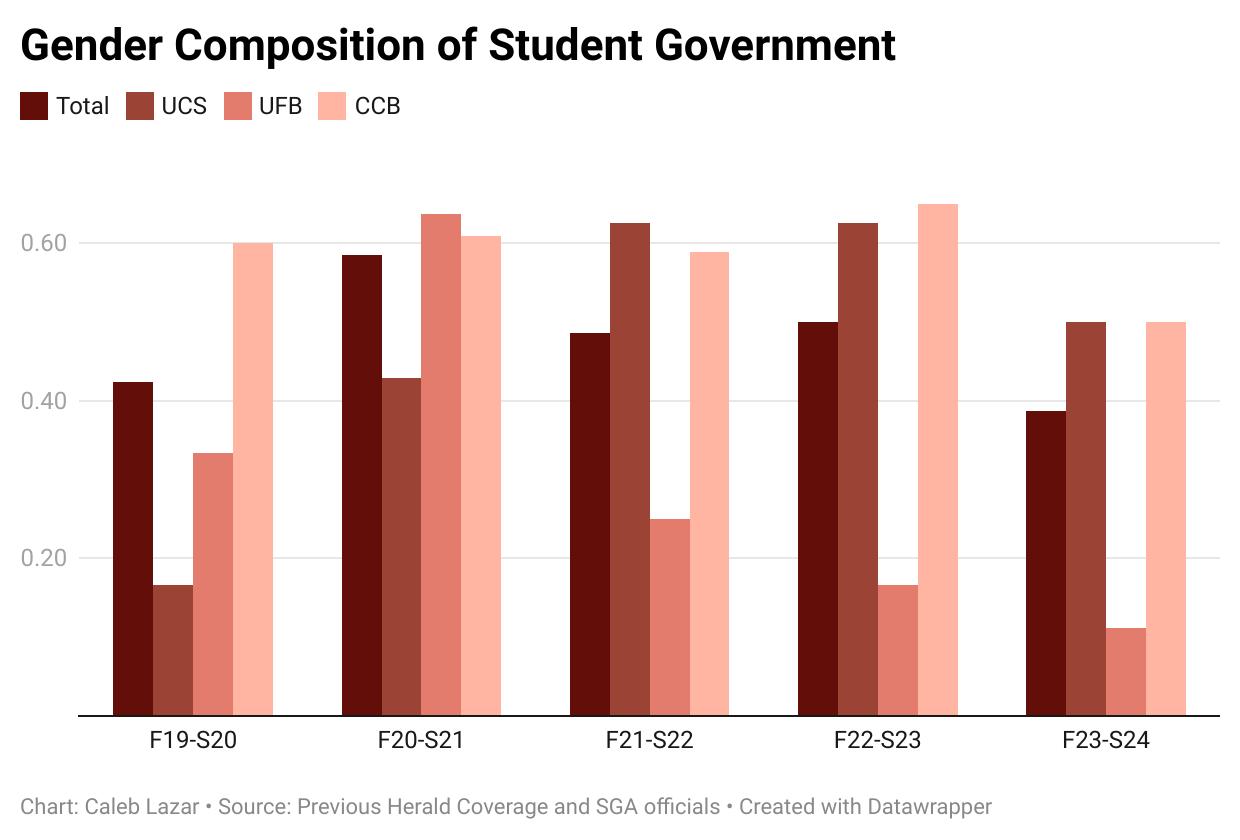
“I don’t think we (can) say that campus is not electing women,” said current UFB Vice Chair and Chairelect Arjun Krishna Chopra ’25. “It really comes down to how do we ensure that women run for UFB.”
In the recent spring elections for the 2023-24 year, there were two female candidates out of 17 for all UFB positions. The incoming board has one female member, Naomi LeDell ’26, who earned the most votes out of all elected at-large representatives, according to an s GA email. UFB will hold elections in the fall for first-year representatives.
In the 2021 vice chair special election, s pencer-Blume was the only female candidate. A majority of candidates were male in the at-large representative special election.
Chopra said he hopes UFB will work with “all affinity groups on campus to ensure that there is an adequate publicization of what UFB is,” he said. While Chopra and Ian Kim ’25 are both men, the pair will focus on “outreach to ensure gender diversity and … balance,” Chopra said.
Catherine Jia ’26 — a current firstyear representative and UFB’s only other female member — said she first learned about UFB during the activities fair in fall 2022. “I really wanted to know what was happening on campus,” she said. “I knew I wanted to do more finance or business, so I thought this was a very collaborative way to get started on that.”
s he added that her experience on the board has been “very inclusive.”
“It’s not a different experience because I’m a female,” she said, adding that no presenters have taken issue with the board’s gender breakdown — while noting that more gender diversity could add different perspectives.
p aige Richter ’24, finance chair for Women in Business, described the overall environment to be “non-intimidating” when she presented WiB’s budget, even though she did notice that the board consisted of mostly men. The fact that the chair was a woman made UFB seem less male-dominated, Richter added.
A diverse board would ensure that “we are not ignoring due to unconscious bias or conscious bias people of certain groups,” Chopra said. “That matters beyond just gender and race.”
Next year, three of six sGA leadership members will be women, Borges noted.
In this spring’s elections, an amendment was passed allowing UFB to fill new positions by appointment. “Hopefully … we’re gonna be able to fill these administrative positions with an equal representation of men and women,” Chopra said.
Jia, who did not run in the recent spring elections, said that she plans to run in the internal election. “I wanted some more diverse experiences on UFB,” she said.
CCB: “Anyone is able to thrive”
When Carina sandoval ’23, current CCB senior co-president, joined the first-year board in 2019, the senior co-presidents were two women of color: s achar and Liana Lum ’20 MD’24.
“I just really thought that was
amazing,” s andoval said.
Women of color have consistently led CCB’s senior classes over the last four years: Ella Joshi ’21 in 2020-21, Bree Zhang ’22 and Mel Cui ’22 for 2021-22 and sally Zhang ’23 and sandoval this year. Next year, one of two senior co-presidents, Becca Erdenbulgen ’24, is a woman of color.
When s achar joined the board in 2016, she was among a group of CCB members promoting diversity and inclusion within the organization.
During sachar’s first year, CCB had roughly six women of color across the 24 positions, she said. sachar tied that dynamic to CCB’s historic relationship to Greek life on campus, as predominantly white students affiliated with fraternities and sororities funneled “the same cohort of friends” to apply for board positions, she said.
According to Drashti Brahmbhatt ’19, when she was first-year board president in 2015, her board noticed that the three other class years’ boards were “not as representative of the larger student body as” theirs.
“We learned … (about) a long-standing trend in class board history of mainly electing white, cisgender men,” Brahmbhatt wrote in a message to The Herald. Her board also “began to flag additional issues such as how our general body meetings (run), how our events are not as inclusive as they should be and our larger relationship with providence.”
In 2016, s achar remembered watching Brahmbhatt having to “go out of her way to make a point” because internal conversations were dominated by male upperclassmen.
That fall, the sophomore class board — headed by Brahmbhatt and consisting of six members — spearheaded the creation of a diversity, equity and inclusion committee across years of CCB aimed at creating a “more safe and inclusive space for all identities,” she said.
In its first meetings, the committee “began to discover the root causes” of why elected boards were not diverse and “organized educational training” for all CCB members, Brahmbhatt said.
According to s achar, the committee also aimed to foster inclusivity and accessibility in CCB events, advocating for physical accommodations as well as equitable marketing strategies.
During her time, CCB shifted toward more diverse events focused on students who may not have been included previously and “stress relief, self-improvement and self-help.”
When s achar became senior co-president of CCB in 2019, 60% of the elected board consisted of women.
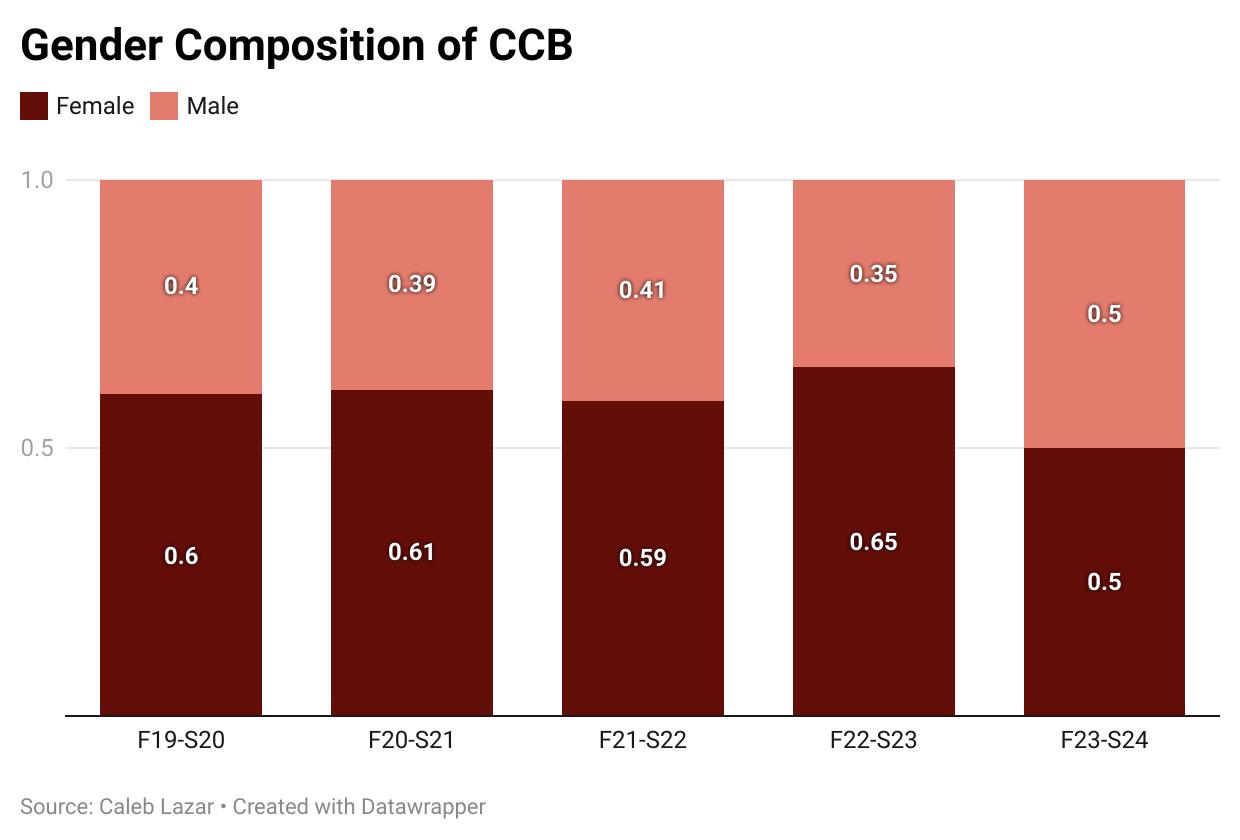
According to s andoval, CCB recently began an internal practice of surveying members about their comfort level in dealing with certain situations to better distribute responsibilities. some of these situations included interacting with an intoxicated person or with the providence police Department, “which (is) male-dominated.”
CCB continues to be a place where “anyone is able to thrive,” s andoval added.
UCS: Considering representation
While elected UC s positions have been balanced in gender in recent years, only six members of the current UC s executive board are women out of 19 positions.
“I think (gender breakdown in UC s ) has more to do with who is en -
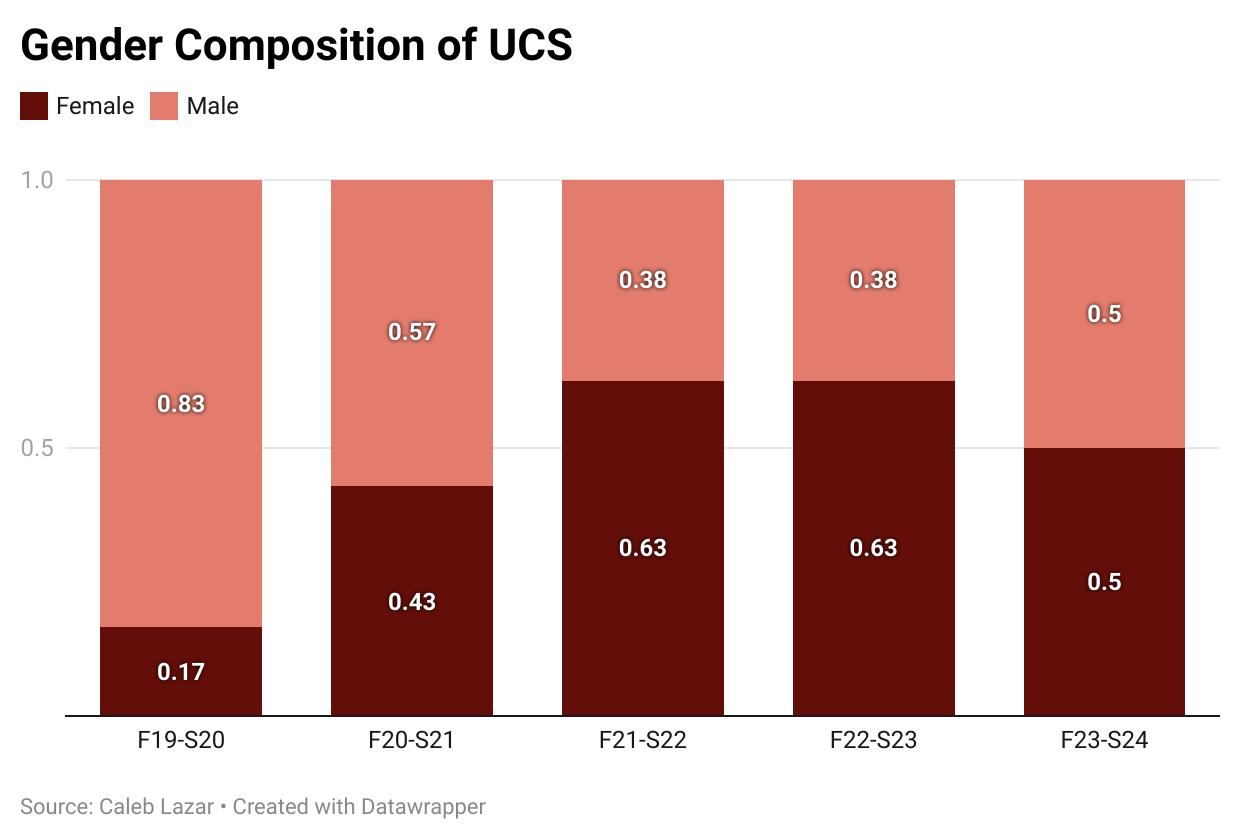
W EDNE s DAY, Ap RIL 19, 2023 3 THE BROWN DAILY HERALD | NEWS
GENDER FROM PAGE 1 SEE GENDER PAGE 8
Students discuss state of nutrition in Brown dining halls
BY SAHIL BALANI STAFF WRITER
Kira Bierly ’23.5 is conscious about nutrition and tries to eat as healthily as possible. But as a vegetarian on Brown’s meal plan, “I’ve often struggled to get enough protein in the dining halls on campus,” she wrote in an email to the Herald.
some other students on the meal plan shared this sentiment, while others thought there were solid options. The Herald spoke to students, dining management and Undergraduate Council of students representatives about the state of nutrition at Brown.
Students express concerns about late-night offerings, access to protein
Bierly wrote that she works out most days, which adds to the challenge of getting enough protein to sustain a healthy diet. While trying her best to gravitate towards salad bars, she feels that the dining halls can improve by increasing fruit and vegetable options.
Lena Wu ’26 feels that meal options are nutritious for lunch or dinner before 7:30 p.m. But she expressed concern over the lack of nutrition-rich food available later at night, adding that it is difficult to maintain a healthy diet when the only items available are sugary snacks in vending machines.
The Brown Dining services website includes several “Well-Being Commitments,” which include ensuring that “menus emphasize the use of fresh vegetables, fruits, legumes and whole grains as a featured ingredient” and practicing “‘stealth’ nutrition as a standard operating procedure by using healthy cooking techniques and ingredients in everyday food preparation.”
Lily Harding ’23 wrote in an email to The Herald that a “variety of dining halls … make it so there’s options that meet a lot of different nutritional needs and wants.” Harding added that since she does not consume “milk, dairy or eggs,” she is very considerate and care-
ful about finding sources of protein.
Brown Dining services’ approach to nutrition at their various dining halls includes ensuring that options are available “for all people looking to eat healthfully,” wrote Michelle Blais, director of wellness and nutrition, in an email to The Herald.
Blais currently collaborates with chefs to make the menus more nutritionally balanced and also works with students who have food allergies to accommodate their requirements. While a “healthy” meal to one person might include lean animal protein, rice and a vegetable, a “healthy” meal for another might be strictly vegan and include no added sugar, Blais wrote. “We try to accommodate all students’ needs,” she added.
Harding expressed her appreciation for the Verney-Woolley Dining Hall and the sharpe Refectory, adding that she likes the tofu in the salad bar, the “Impossible Nuggets on Fridays” and the black bean burger at the Ratty. since she is also a distance runner on the track and field team, Harding wrote she is conscious about getting enough nutrients “for success in my sport as well (as) my health.”
she added that while she feels the access to fresh fruits and vegetables at dining halls is “underrated,” she wishes
there were more tofu or vegan sources of protein for breakfast at the Ratty shane Weiner ’23, who has been on the meal plan for four years, shared similar sentiments regarding finding quality protein. In an interview with The Herald, Weiner expressed his concerns over a lack of “lean sources of protein” at the dining halls, especially as he trains for weight lifting. While the dining halls do provide different meats, his lifestyle still does not permit eating them because the meats are usually covered in “sauces and oils.”
Fope Akinyede ’26 wrote in an email to The Herald that it sometimes becomes difficult to obtain a healthy meal due to the “starchy and carby basis of many of the meals.” she also added that she is trying to improve her meals by finding healthier bases such as quinoa, potatoes and sweet potatoes.
Akinyede, like Wu, wrote that she struggles to find nutritious food at night, adding that other dining halls — Andrews Commons and the Ivy Room — could benefit from increasing their fruit and vegetable offerings.
Initiatives from Brown Dining Services, UCS
In response to student concerns over a lack of information about nutrition, UCs worked with Brown Dining ser-
CALENDAR
vices to create a “Dining Hall Common Items Nutritional Values” spreadsheet, which was launched on March 8. The spreadsheet includes macronutrient values for popular food items such as chicken sandwiches from Josiah’s, Ratty turkey burgers and Blue Room muffins. Nutritional facts for daily offerings at the Ratty and the V-Dub are available on MyMeal.
In an email to The Herald, UC s p resident Ricky Zhong ’23 credited “students from various walks of campus life asking us for nutritional info” which led to the compilation of this information. Zhong added that UCs is also “advocating for the incoming dining system to display macronutrients for every dish.”
While this new addition of information is a step in the right direction, Bierly wrote that she wishes “information like this was more widely distributed.”
Wu added that it would be helpful if these nutritional facts are made visible “while waiting in line since it makes better decision-making about diets.”
Akinyede expressed a different sentiment, writing that she “wholeheartedly oppose(s) calorie counting. … It is best if it is available for individuals to seek out for themselves, instead of having it obnoxiously in front of people, as this can be very triggering for
TODAY’S EVENTS
seminar by sorel Writer in Residence: Jean-Cristophe Bailly
12:00 p.m. - 1:00 p.m.
Rochambeau House, Music Room
Development, Institutions, and political Economy seminar
12:00 p.m. - 1:30 p.m.
Robinson Hall, Room 301
TOMORROW’S EVENTS
Earth Week 2023: Climate solutions for a Warming World
11:00 a.m.
Salomon Center 203
Elaine Gan: “Time Change: Miracles, Monsters and Machines”
12:00 p.m.
71 George St 101
those suffering from eating disorders,” Akinyede wrote. she had not seen the spreadsheet before.
Harding added that while she finds the specific nutritional information to be helpful, she appreciates the fact that it is not visible when looking at the dining menus, as she does not find it “constructive” and personally tends to ignore “number-based nutrition information.”
According to Blais, one of the best ways for students to navigate the dining hall and make informed decisions about their food choices is by “using the icons presented on the menus,” which indicate which dishes are halal, vegan, vegetarian and gluten-free.
The gluten-free label “does not take into account cross-contact with gluten in preparation,” Blais added. she recommended that students speak to supervisors regarding their allergy conditions.
Blais wrote that new BDs initiatives include an “integration of a new menu management software” which would expand upon the current MyMeal platform. The new software could potentially be available for students in fall 2023 and will provide more extensive nutritional information for food on campus, allowing students to better plan their meals, she added.
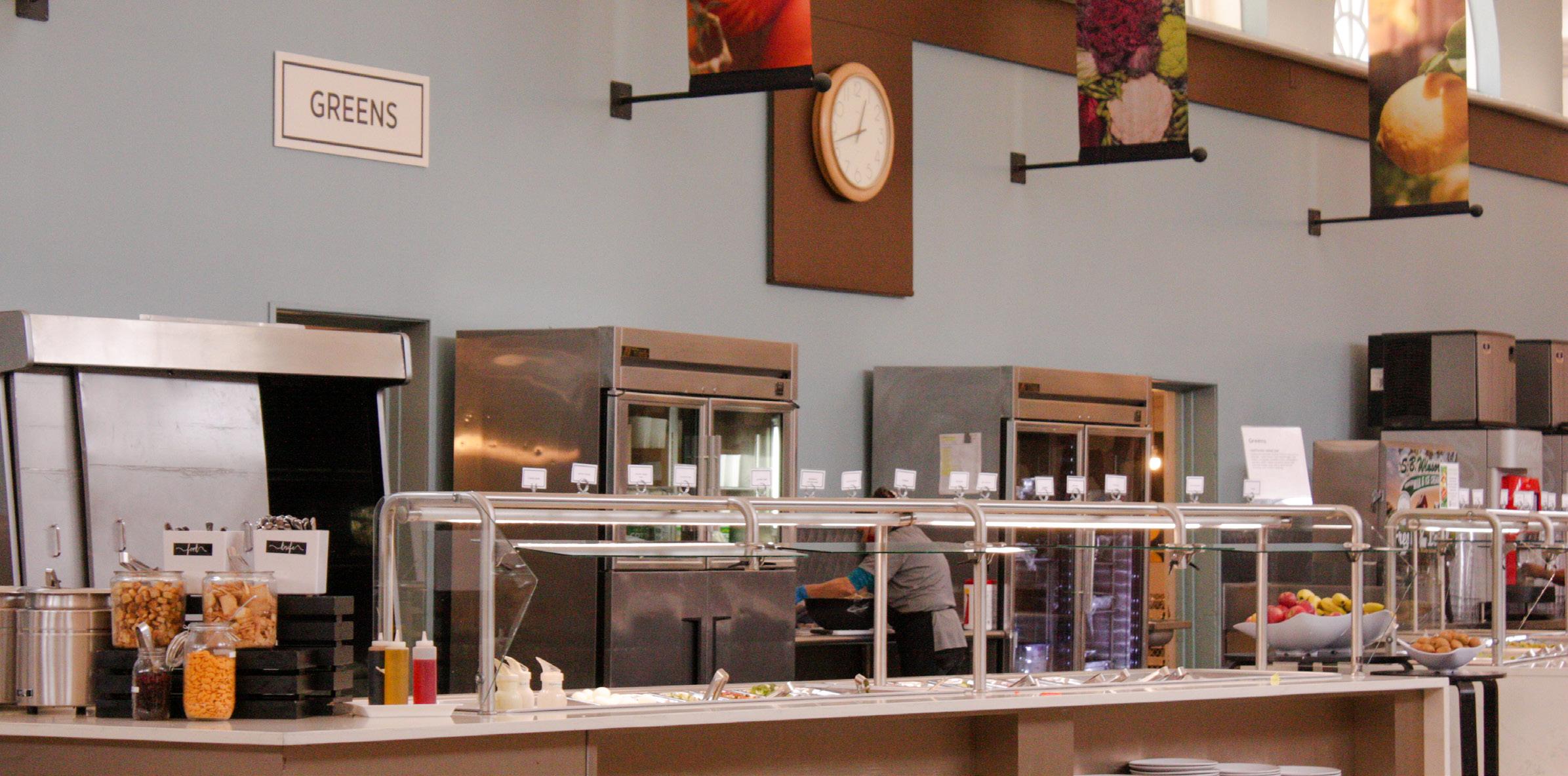
Barclays sales & Trading Info session at Brown
12:00 p.m. - 1:30 p.m.
CareerLAB
Queer Mocktail Mixer
7:00 p.m. - 9:00 p.m.
Stonewall House
Reading Textile Traces of Modern Greece
12:00 p.m. - 12:50 p.m.
Rhode Island Hall 108
TAps presents Artist Talk with petra Kuppers
7:00 p.m.
Pembroke Hall 305
4 W EDNE s DAY, Ap RIL 19, 2023 THE BROWN DAILY HERALD | NEWS
FEBRUARY S F Th W Tu M S 8 7 6 9 3 4 5 15 14 13 16 11 12 10 22 21 20 23 18 19 17 26 24 25 1 2 27
28 APRIL S F Th W Tu M S 5 4 3 6 3 1 2 12 11 10 13 8 9 7 19 18 17 20 15 16 14 26 21 22 1 2 27 28 S Th W Tu M S 8 7 6 9 3 5 15 14 13 16 12 10 22 21 20 23 19 17 26 24 1 2 27 28 29 30 11 18 25 4
UNIVERSITY NEWS
students generally satisfied by dining hall options, concerned about protein sources
KAIOLENA TACAZON / HERALD
In response to student concerns over a lack of information about nutrition, UCS worked with Brown Dining Services to create a “Dining Hall Common Items Nutritional Values” spreadsheet, which launched March 8.
Gun bills held for further study in House committee hearing
Advocates on both sides swarm state House, testify for hours on gun-related bills
BY JACOB SMOLLEN METRO EDITOR
The R.I. House Judiciary Committee recommended that 27 gun-related bills up for consideration be held for further study — including legislation which would ban assault-style weapons — at a hearing Monday afternoon.
The decision to hold the bills is “not substantive and does not signify any position on the merit of bills,” Committee Chair state Rep. Robert Craven (D–North Kingstown) explained before the hearing got underway. “The motion is procedural only and simply allows the committee sufficient time to review both verbal and written testimony.”
The hearing lasted over seven hours in total — keeping legislators in the committee room well past 9 p.m.
Assault weapons ban
Introduced by state Rep. Jason Knight (D–Barrington, Warren), H5300, would “ban the possession, sale and transfer of assault weapons.” That category would include three classes of semi-automatic firearms, including certain types of semi-automatic shotguns, rifles and “a very very small class of pistols,” according to Knight.
Assault weapons acquired before passage would be “grandfathered” under the law, provided that the weapons are properly registered. If the legislation — which has been introduced in the House every year since 2019 — passes, Rhode Island would become join several other states that have enacted a ban on certain types of assault-style weapons.
Knight said that the prevalence of mass shootings across the country makes the bill necessary. There have been more than 160 mass shootings so far this year in the United s tates, according to the New York Times.
“I do not want to be the legislator who wakes up one morning after something, God forbid, as awful happened in Rhode Island and be a part of a body that didn’t do everything it possibly could,” Knight told the committee.
The legislation aims to build upon three gun control bills passed by the general assembly last year. The three bills limited magazine capacity, raised the minimum age for purchasing rifles and shotguns from 18 to 21 and prohibited the open carry of long guns, The Herald previously reported.
“Every year, we come back up here because there’s a proliferation of gun bills trying to once again restrict our second amendment rights,” Frank saccoccio, president of the Rhode Island 2nd Amendment Coalition — the NRA state association — told the committee. “Every year, we have to come up here and say to the legislators, ‘why don’t you go after the criminals, why don’t you leave the law-abiding citizen alone.’”
A recent study with support from the National Institute of Justice found that in over 75% of known mass shooting cases — events in which there were four or more casualties — the perpetrator “purchased at least some of their guns legally.”
Governor Dan McKee also wrote in “strong support” of the assault weapons ban in testimony submitted April 14 to the committee. Lt. Gov. s abina Matos shares this stance, adding in a separate letter that the gun control bills are “an issue of equity” because “gun violence has a disproportionate impact on communities of color.”
Safe storage
The committee also heard testimony on H5434, which would require guns to be stored in locked containers when not being carried by their owners.
“With this bill, we are asking for the absolute bare minimum — that if you own a dangerous weapon, you secure it in your home,” said state Rep. Justine Caldwell (D–East Greenwich, West Greenwich), who introduced the legislation. According to Caldwell, this is the fifth year in a row that the
legislation has been introduced.
House minority leader Michael Chippendale (R–Coventry, Foster, Glocester) argued that “responsible firearm owners” will be the only Rhode Islanders who will follow the law if passed and they “already take strenuous steps to ensure that accidents don’t happen.” He added that the legislation will prevent Rhode Islanders from properly protecting themselves and their homes.
s accoccio was also among several people who raised concerns that this ban and a separately introduced safe storage bill would be unconstitutional.
In response, Knight read a letter submitted by Attorney General peter Neronha, in which he wrote: “We are confident that this legislation is constitutional and that we’re prepared to defend any challenge that may arise.”
Advocacy groups
With the committee room full, the R.I. s tate House atrium was a sea of yellow, orange and red shirts as lawmakers discussed the legislation and heard testimony.

Yellow was the color worn by gunrights supporters, among them the R.I. s econd Amendment Coalition, Rhode Island Revolver and Rifle As -
sociation and other organizations.
Members of the R.I. Coalition Against Gun Violence and Moms Demand Action wore orange and red respectively. The Herald spoke to members of each group about their stances on the proposed bills.
“Hearing days bring out more color,” said Cindy Capra ’78 p’14 MaT’06, a credentialed family nurse practitioner, who was with RIAGV.

Capra went to the s tate House to support both the assault weapons ban and safe storage bills. she emphasized gun violence as a public health issue and said she is more optimistic than ever about the proposed legislation.
“Last year was a very successful year, but this year we’ll build on that,” she said.
s ue Larson, part of the leadership team for R.I. Moms Demand Action Volunteers, also said that the safe storage bill and assault weapons ban were priority bills. s h e emphasized that Moms Demand Action is not against the s econd Amendment, but she feels that “weapons of war have no place in our communities.”
“We just feel that we need better regulation and we need to make sure that guns don’t fall into the hands of the wrong people,” she added.
According to Brenda Jacob, secretary and lobbyist for the Rhode Island Revolver and Rifle Association, the proposed gun control bills are not about safety but rather “about control.” Jacob called the safe storage bill “a geographical issue,” explaining that she keeps a shotgun by her bed at night on her rural farm.
“I don’t think criminals are ever going to adhere to (these bills) and the only ones that they’re hurting are the hard-working, law-abiding citizens,” she said.
Rick Gregoire, who came to the state House with the second Amendment Coalition, understood the “concern for public safety,” but said that people have misconceptions about gun ownership. He called the gun-control measures of recent years part of a pattern of “constant encroachment.”
“They say this is it and then next year it comes a little further and the next year it comes a little further,” Gregoire said. “What’s next?”
The s enate Judiciary Committee will hear testimony on companion bills for the assault weapons ban, safe storage and other gun-related legislation next week.
W EDNE s DAY, Ap RIL 19, 2023 5 THE BROWN DAILY HERALD | NEWS
METRO
Additional reporting by Sam Levine
JACOB SMOLLEN / HERALD
State Rep. Jason Knight (D–Barrington, Warren) said that the prevalence of mass shootings across the country makes an assault weapon ban necessary.
Gaber ’23: College is just the beginning of our adult lives
“College is the best four years of your life.”
If I had a nickel for every time I heard that phrase, I could have paid my tuition in cash. Every time I think about that statement, it seems even bleaker. Why would anyone want to peak that early? As I reach the end of my undergraduate career, however, I can see some merit in that claim. I’ve made great memories and better friends, and I’ve learned far more than my transcript can attest to. Nevertheless, as graduating seniors, we must all remember that college is only the very beginning of our adult lives.
The idea that our college years are supposed to be the best years of our lives is unrealistic at best and depressing at worst. For the class of 2023 in particular, college has been a whirlwind: Our early days were defined by pre-COVID normalcy, but the pandemic covered a lot of our collegiate ground. We found new ways to stay connected, but the truth is that our joys were limited. s o much for parties in sweaty basements and casual run-ins with classmates at Mike’s Calzones. s ure enough, these things came back to us, if not last year, then certainly this year. s omewhere in the mess of time flying and mental health struggles, our college years settled firmly behind us. And yet we’re told that, at 21 and 22, we’ve already reached the
apex of our encounters with learning, fun, heartbreak, joy, failure and every other interesting experience out there. But it seems impossible to me that the most interesting thing that we’ll ever do is sit over-caffeinated in the Blue Room, stressed about a paper that we should have started writing days ago. Our college days may be behind us, but what
chological Association offers specific ways to cope with post-grad depression and anxiety certainly suggests that there will be rocky times ahead. It’s for that reason that I won’t fall into the trap of saying that our 20s will be “the best years of our lives;” that would be just as flawed as saying the same about college. But the hopeful difference between
of uncooked goo,” I say with equal parts irony and sincerity. Having grown from that point into what I can now proudly call a solidly formed person, I’m well aware of the fact that moving into a new age cohort with different life expectations will likely lead to a feeling of underdevelopment or unpreparedness. It’s important to accept that possibility and to embrace uncertainty, aimlessness and a lot of trial and error.
is in front of us is a broad spectrum of possibilities that can either scare us or empower us, depending on our level of optimism.
It is important, however, to recognize the legitimate challenge that the transition from college to “the real world” poses. Moving at any point in life can be an emotional trauma, as leaving an established routine and a stable support system can be disorienting and disquieting. The fact that the American p sy -
the rest of our adult lives and college is that, after college, we have much more time to balance what we lose with what we gain, whatever that may mean for each of us.
It’s also important to resist the pressure to see ourselves as fully-formed adults who need to have everything figured out right now. I frequently joke that before college, not only was I not yet an adult, but I wasn’t even a person. “I was just an amorphous blob
It’s easy to feel like everything is coming to an end right now, and it’s easy to get overwhelmed by that. And in truth, a lot is coming to an end. But so much more is beginning. It’s hard to trust the future to deliver when you can’t see it yet. Not all of us are religious people, but this is where faith of any kind is critical. We don’t have to see everything that awaits us — careers, love, family, success, peace of mind — to believe it will all be ours soon enough. We may not be cats who always land on our feet, but, if we keep practicing, we just might stick the landing when we least expect it.

Yasmeen Gaber ’23 can be reached at yasmeen_gaber@brown.edu. Please send responses to this opinion to letters@ browndailyherald.com and other op-eds to opinions@browndailyherald.com
SINCE 1891
THE BROWN DAILY HERALD
133rd Editorial Board
Editor-in-Chief Will Kubzansky
Managing Editors Katy Pickens
Alex Nadirashvili
Senior Editors Augustus Bayard
Caleb Lazar
Peter Swope
Kaitlyn Torres
Post- Magazine
Editor-in-Chief Kimberly Liu
News Metro Editors Emma Gardner
Rhea Rasquinha
Jacob Smollen
Julia Vaz
Science & Research Editor

Haley Sandlow
Senior Science & Research Editor
Gabriella Vulakh
Arts & Culture Editors
Aalia Jagwani
Finn Kirkpatrick
Rya Vallabhaneni
Sports Editor Linus Lawrence
University News Editors
Sofia Barnett
Charlie Clynes
Emily Faulhaber
Grace Holleb
Sam Levine
Neil Mehta
Haley Sandlow
Kathy Wang
Digital News Director of Technology
Swetabh Changkakoti
Opinions
Head Opinions Editor
Alissa Simon
Opinions Editors
Anika Bahl
Bliss Han
Melissa Liu
Jackson McGough
Multimedia
Illustration Chief
Ashley Choi
Photo Chiefs
Elsa Choi-Hausman
Dana Richie
Photo Editors
Mathieu Greco
Claire Diepenbrock
Lilly Nguyen
Kaiolena Tacazon
Social Media Chief
Sahil Balani
Social Media Editors
Emily Faulhaber
Coco Huang
Alyssa Sherry
Kaiolena Tacazon
Production Copy Desk Chief Brendan McMahon
Design Chief
Neil Mehta
Design Editors
Sirine Benali
Maddy Cherr
Ashley Guo
Gray Martens
Business
General Managers
Joe Belfield
Andrew Willwerth
Sales Director
Alexander Zhou
Finance Director
Submissions: The Brown Daily Herald publishes submissions in the form of op-eds and letters to the Op-eds are typically between 600 and 900 words and advance a clear argument related to a topic of campus discourse. You can submit op-eds to opinions@browndailyherald.com.
Letters to the editor should be around 250 words and respond to an article or column that has appeared in The Herald, or critique or commend The Herald’s editorial decisions. You can submit letters to the editor to letters@browndailyherald.com.

Submissions undergo multiple rounds of editing. These rounds of editing generally take place over the course of one evening, and you may have to respond to edits late in the evening. If you know you will be unable to do so, please mention that in your email, and we will do our best to work with you.
Submissions can build on reporting from The Herald, reporting elsewhere, official statements from the University or other groups and other reputable sources, but they cannot break news or contain information that The Herald cannot verify. Because we cannot publish unsubstantiated information, failure to provide appropriate sources may mean we have to modify or remove unverified claims.
The Herald will not publish anonymous submissions or submissions authored by organizations. Leaders of student organizations can be identified as such but cannot write under the byline of their organization.
The Herald cannot publish all submissions it receives and reserves the right to edit all submissions.
All submissions to The Herald cannot have been previously published elsewhere (in print or online — including personal blogs and social media) and must be exclusive to The Herald. Once your submission is published in The Herald, The Brown Daily Herald, Inc. owns the copyright to the materials.
Commentary: The editorial is the majority opinion of the editorial page board of The Brown Daily Herald. The editorial viewpoint does not necessarily reflect the views of The Brown Daily Herald, Inc. Columns, letters and comics reflect the opinions of their authors only.
Corrections: The Brown Daily Herald is committed to providing the Brown University community with the most accurate information possible. Corrections may be submitted up to seven calendar days after publication. Periodicals postage paid at Providence, R.I. Postmaster: Please send corrections to P.O. Box 2538, Providence, RI 02906.
Eli Pullaro
Editorial Page Editor
Kate Waisel
Julian Beaudry
Nadia Bitar
facebook.com/browndailyherald @browndailyherald @browndailyherald
@the_herald
Advertising: The Brown Daily Herald, Inc. reserves the right to accept or decline any advertisement at its discretion. 88 Benevolent St., Providence, RI (401) 351-3372 www.browndailyherald.com Editorial: herald@browndailyherald.com Advertising: advertising@browndailyherald.com
The Brown Daily Herald, Inc. is a financially independent, nonprofit media organization bringing you The Brown Daily Herald and Post- Magazine. The Brown Daily Herald has served the Brown University community daily since 1891. It is published Monday through Friday during the academic year, excluding vacations, once during Commencement and once during Orientation by The Brown Daily Herald, Inc. Single copy free for each member of the community. Subscription prices: $200 one year daily, $100 one semester daily.
Copyright 2023 by The Brown Daily Herald, Inc. All rights reserved.
6 W EDNE s DAY, Ap RIL 19, 2023 THE BROWN DAILY HERALD | COMMENTARY
“As graduating seniors, we must all remember that college is only the very beginning of our adult lives.”
meet more regularly than trustees and play a more active role in University administration.
Full Corporation meetings occur three times each year, taking place in February, May and October. Corporation members also meet regularly to fulfill their requirements for the body’s three main committees — the Committee on Academic Affairs, the Committee on Budget and Finance and the Committee on Campus Life — and 12 standing committees, which address specialized issues in University governance. It is through these committees that “much of the work of the Corporation is done,” according to the Corporation website.
What professional backgrounds do Corporation members have?
Twenty-three corporation members, representing nearly half of the organization, have made their careers in finance. Of these, all hold or have held significant leadership positions, and at least 14 founded or co-founded financial service firms. Financial duties, including the approval of the University’s budget and the formal acceptance of gifts, form a significant portion of the Corporation’s regular responsibilities.
University spokesperson Brian Clark wrote in an email to The Herald that members of the Corporation serve as “ultimate fiduciaries” of the University and provide “oversight to strategies and policies designed to preserve and enhance the University’s financial strength” when asked about the representation of financial backgrounds on the board.
Academia is the second-most common professional sector for Brown’s fellows and trustees, followed by art and entertainment and medicine.
The Corporation selects members who “have the professional and personal backgrounds needed to meet their fiduciary and oversight responsibilities,” according to the Corporation website.
Where did Corporation members attend college?
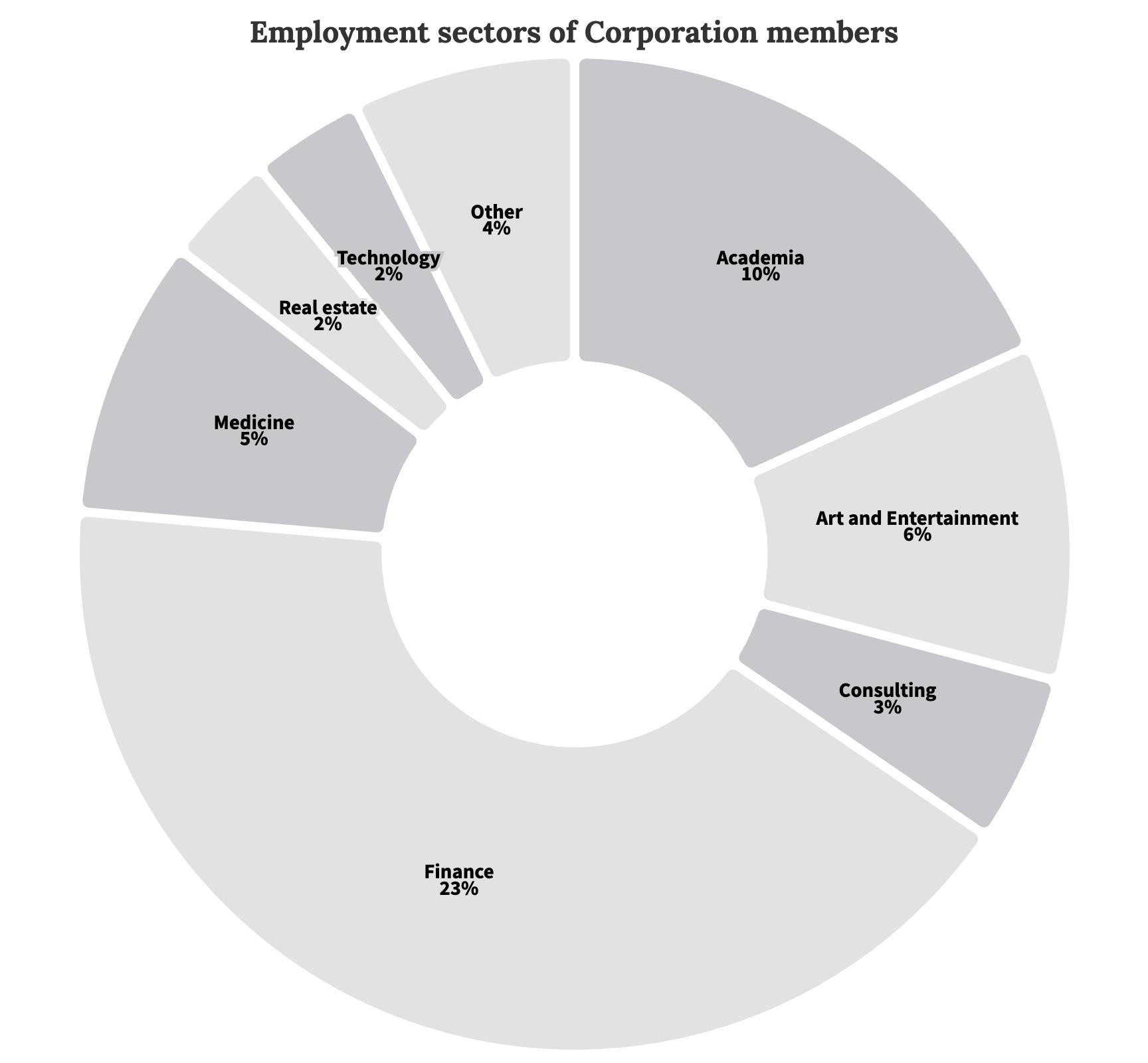
Of the Corporation members who received their undergraduate degree in the United states — at least 52 — 39 graduated from Brown, and all but three attended schools in the Northeast. The University of pennsylvania is the second-most represented institution in the Corporation, with two members counting the school as their alma mater.
Harvard, Columbia and Brown are the most represented graduate schools in the Corporation, with at least 10, eight and six graduates, respectively.
What did members of the Corporation concentrate in at Brown?

The most common degrees earned by members are in economics and concentrations that would later become International and public Affairs, including the now-defunct international relations, public policy and development studies concentrations.
While computer science has ranked as the highest-awarded degree at the University for several years — over 10% of students graduated with a degree in computer science in 2022 — only one Corporation member, Trustee William Zhou ’20, holds a Brown undergraduate computer science degree. Computer science was also the most popular concentration among the class of 2020, which Zhou belongs to. science, Technology, Engineering and Math degrees are far less represented among the diplomas of Corporation members than those of recent Brown graduates.
Together, 53.7% of degrees awarded to the class of 2022 were in life or physical sciences. This figure is up from 44.9% for the class of 2013, according to the Office of Institutional Research.
But, for Corporation members, that figure is far smaller. Only 12 of 47 of Brown undergraduate degrees — or 25.5% — awarded to Corporation members were in life or physical sciences.
When did Corporation members graduate?
The Herald identified undergraduate class years for 51 of 53 members of the Corporation.
Of these members, 62% graduated between 1980 and 1994.
The Corporation also includes two trustees from a recent graduating class, known as new alumni trustees. These individuals are selected from a slate of candidates by recent alums and students in their final year of study at Brown, according to the Corporation’s website. These members serve two-year terms.
Candidates for the role are approved by a joint subcommittee between the Corporation and the Brown Alumni Association.
Where do Corporation members spend their political dollars?
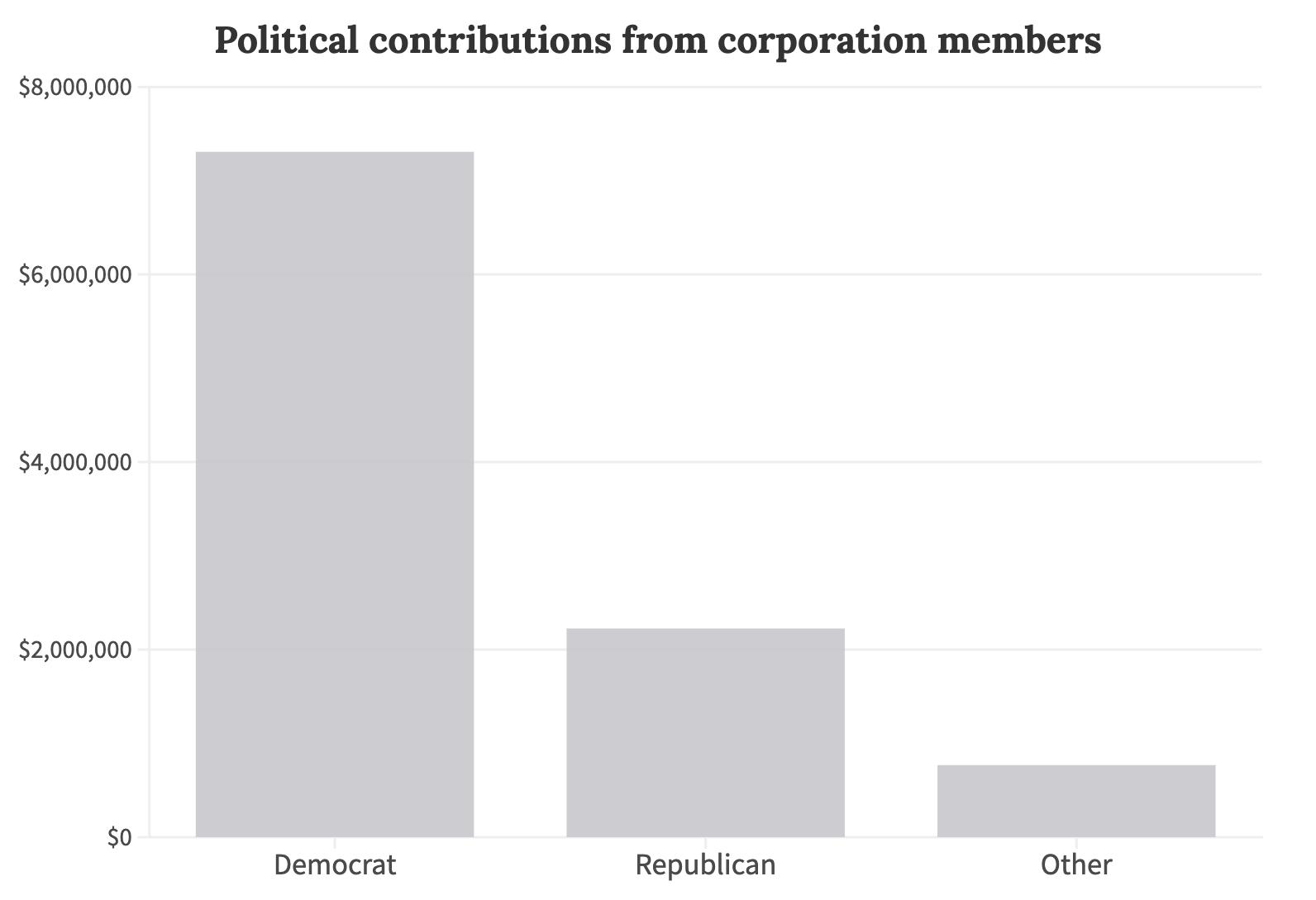
political donations from Corporation members to candidates and political action committees have grown dramatically over the past two decades.
since 2000, Corporation members have given over $10 million in political donations, according to the Federal Election Commission. since then, the majority of contributions — over $7 million — have gone to Democratic-affiliated causes.
Donation data from the FEC is not comprehensive. FEC rules do not require the filing of contributions under $50, meaning they may be absent from public data.
Brown staff members are free to participate in partisan political activity, but they “may not give the appearance that they are representing the University” and cannot conduct any partisan political activity during working hours, according to
the University’s political Activity policy.
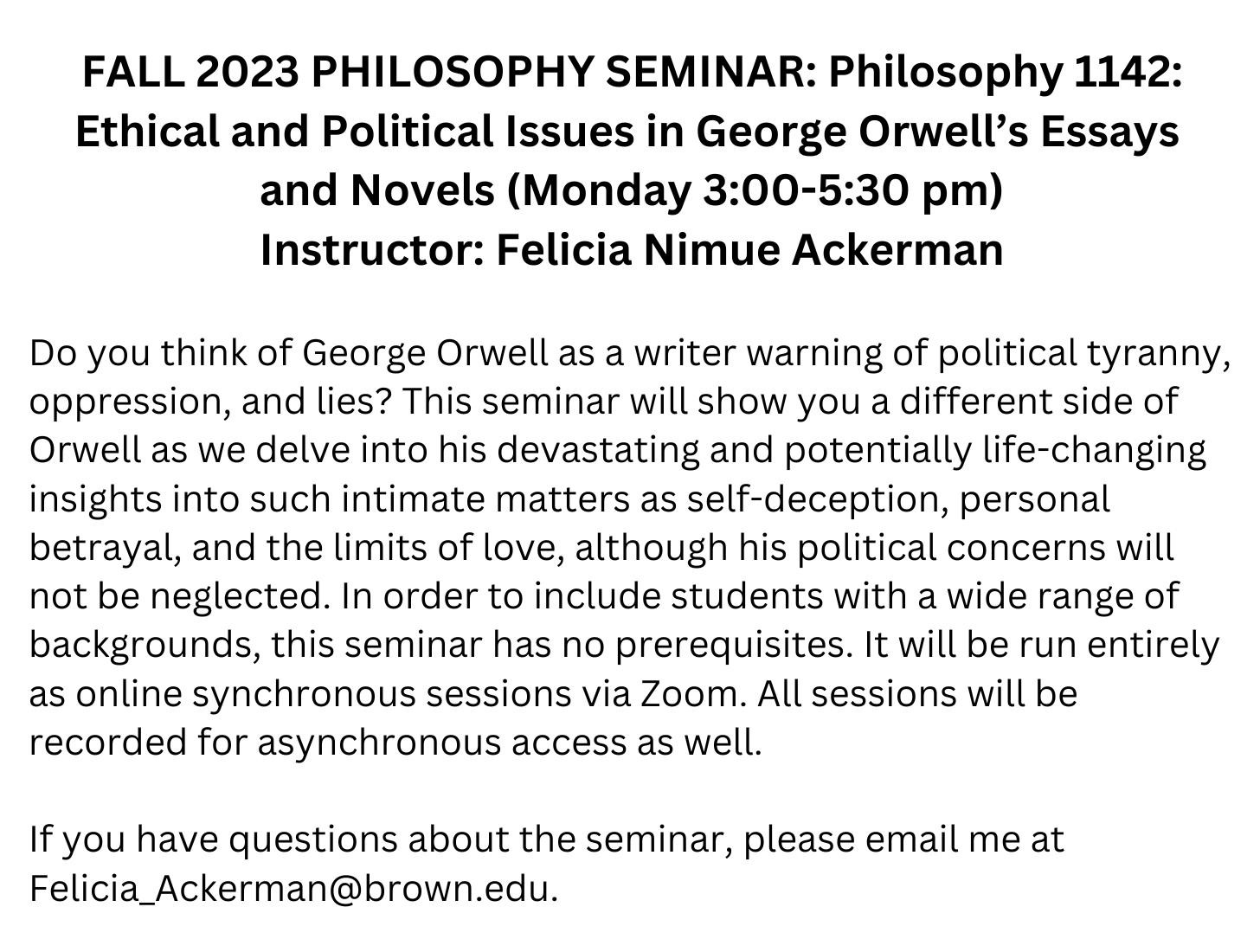
In 2020, Corporation members donated over $2.3 million to Democrats. Corporation members also have donated approximately $2 million to Republican-affiliated individuals and organizations.
Nearly half of all funding given to Republican-affiliated causes came in 2022, largely due to two donations, each of $500,000, from Corporation trustee Orlando Bravo to conservative super pAC
America for Everyone. Bravo did not respond to requests for comment on the two donations.
According to FEC data, president Christina paxson p’19 p’MD’20 has donated $25,750 to political candidates and causes since 2000 — all Democratic-affiliated — including a $2,500 donation to the committee of U.s. Rep. David Cicilline (D-R.I.) in 2021. paxson declined to comment on the donations.
W EDNE s DAY, Ap RIL 19, 2023 7 THE BROWN DAILY HERALD | NEWS
CORPORATION FROM PAGE 1
Women’s crew posts strong showing in Ivy Invitational
Team records 12 firstplace finishes, goes undefeated against Ivy League opponents
BY AUSTIN XIANG SENIOR STAFF WRITER
The women’s crew team placed first in 12 of the 14 Ivy League Invitational races this weekend at Carnegie Lake in p rinceton, New Jersey. On s aturday, the team faced off against Rutgers University and the University of s outhern California and raced Columbia, Dartmouth, Oregon s tate University and the University of Virginia on s unday.
“I think that I speak for all the coaches, staff and athletes when I say that we were definitely pleased with our results at the Ivy Invitational,” wrote Head Coach John Murphy in an email to The Herald. “It was excellent competition from different leagues including the pAC-12 and I think the team welcomed the challenge.”
On saturday, Bruno set the tone for the weekend, completing a four-race sweep with victories by First Varsity 8, First Varsity 4, second Varsity 8 and second Varsity 4. The largest margin of victory came in the First Varsity 4 race — Brown clocked in at 7:07.901, over 12 seconds faster than second place UsC.
The remaining races that day were canceled due to inclement weather.
“I am especially proud of our ability to stay determined and focused amidst weather-related race delays and cancellations,” wrote Ashley Giannetti ’24 in an email to The Herald via Brown Athletics. “Our performance this past weekend definitely demon -
GENDER FROM PAGE 3
couraged to run and to be in positions of power. And historically, that is generally men,” said sarah Frank ’25, UCs vice president-elect.
In the most recent election, four of the 11 candidates were women.
When UC s p resident-elect and
SMILEY FROM PAGE 1
payment agreements, smiley discussed other ways the city can “get compensated” by these institutions. He pointed to opportunities for both Brown and RIsD students to volunteer in providence public schools, as well as a legislative proposal by his administration that would grant the city 25% of the payroll tax received from new employees of these institutions.
“We can actually encourage (these institutions) to add jobs, instead of fighting their growth as we do now,” smiley said.
The mayor also addressed the city’s housing shortage, telling the audience that “we need more housing” of all types across the city. smiley added that he supports increasing density in parts of the city to meet housing needs in providence, and plans to do so in the rewriting of the city’s Comprehensive plan, which informs development, land use and strategic goals for the municipality.
smiley acknowledged the role of universities in perpetuating the housing
Brown’s First Varsity 4 posted the largest margin of victory on Sunday, finishing nearly nine seconds faster than second place Oregon State in their first race of the day.
strates our vigor and drive as a team, and I am extremely excited to continue building off this momentum over the coming weeks.”
On sunday, the team dropped just two out of the day’s 10 races. First Varsity 8, First Varsity 4 and s econd Varsity 8 each swept their two races of the day, while s econd Varsity 4 and Third Varsity 8 each added one more win to the team’s total of eight victories.
First Varsity 4 once again post-
current Vice p resident Mina s armas ’24 decided to run for last year’s spring elections, she said she had considered running for chair of campus life instead of vice president.
“It’s just an empowerment thing, a confidence thing — I feel like if I didn’t have any experience, I wouldn’t have the confidence to run for a position,” she said.
crisis, as an increase in students living off-campus can encourage landlords to convert single-family homes into apartments, potentially displacing local residents.
“part of the solution is these institutions taking responsibility for their growth,” smiley said, contending that universities in providence need to invest in more on-campus housing before increasing enrollment.
The mayor also discussed his approach to public safety. smiley noted that not all providence residents feel safer when they see a police officer, leading him to acknowledge that “police need to be part of the solution, but not the entire solution” when addressing public safety concerns.
smiley emphasized the need for community input in policing. He pointed to one of his first actions as mayor, which was leading a community-driven search for a new police chief. His administration conducted surveys to gather community input and then held an open forum with selected candidates before ultimately choosing Commander Oscar Perez to fill the role.
ed the largest margin of victory on sunday, finishing nearly nine seconds faster than second place Oregon state in their first race of the day. Against Virginia and Dartmouth in the second race, they narrowly won by less than three seconds.
“I thought that our Varsity 4s racing in the last session was gritty and tough and definitely impressive,” Murphy wrote.
Brown did not finish behind any Ivy League school this weekend, de -
Next year, UC s will have a female president and vice president — sarmas and Frank — for the first time since the 2018-19 academic year.
“It takes a woman to understand what kind of needs that half the student population has on campus,” s GA Elections Chair Joon Nam ’23 noted.
When the UC s Campus Life Com -
According to smiley, his passion for local government stems from his belief that it “impacts people’s lives most directly.” Since taking office in January, he has focused on pursuing “tangible, practical” changes that can make a real difference in the lives of providence residents — and that makes his job “fulfilling,” he said.
Mary shepard, an East side resident, said that the event was the first time she had heard smiley speak since he was elected as mayor. “I am so delighted with this mayor and that he (is holding) a community event,” she said — though she wished that smiley had spent more time addressing his plans to revitalize Downtown.
s haron s teele, president of the Jewelry District Association, said she attended the talk to hear how the mayor approaches the city’s relationship with the University.
“In my world, Brown is our partner, and I am interested in hearing the mayor speak to Brown on the issues we are all dealing with on a daily basis” in the Jewelry District, she told The Herald.
“The relationship between Brown
spite this year being “one of the most competitive years the Ivy League has (had) in a long time,” according to Emily Jaudon ’24.
“It was an excellent opportunity to test our speed against other programs in our conference earlier in the season,” Jaudon wrote in an email to The Herald via Brown Athletics. “We knew that the racing would be close, and I think everyone did a great job navigating race day anxiety and finishing strong across all boats.”
mittee began work on menstrual product initiatives, s armas was chair of the committee, and two other male students were members — Christopher Vanderpool ’24 and Liam O’Connor ’24.
“They were great,” s armas said.
“But I think after a certain point … there wasn’t much that they could contribute to the conversation.”
and the city of extraordinarily long and extraordi narily complicated,” Rosenfeld said. “From our perspective, it was crucial to hear from the mayor directly about Brown’s role in the com munity — what we can do as Brown students to be ac tive citizens in
The conversation “was a fantastic opportunity to hear from an elected official (and) to talk about … how Brown can play a more pivotal and active role in creating a better everyone,” said Cecilia Marrinan ’24, president of Brown Dems.
The team will look to carry this momentum into their race against Cornell at home on the seekonk River this s aturday.
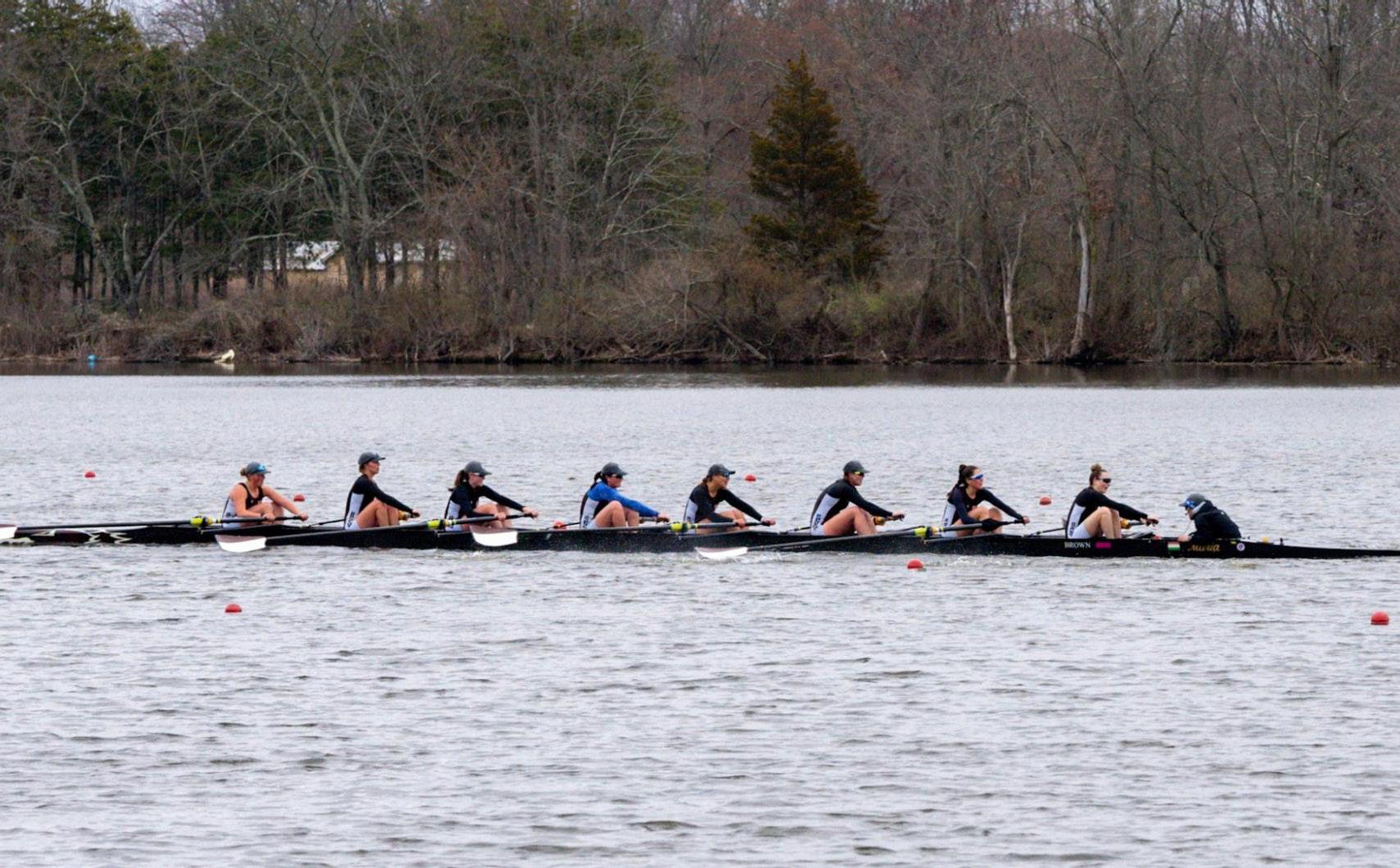
“We will prepare for a strong showing against Cornell by continuing to execute race pieces on our home course, no matter the conditions,” Jaudon wrote. “The tidal nature of seekonk provides challenges, and having multiple opportunities to practice is definitely an advantage that will help us come race day.”
Vanderpool said that committee members took the lead on projects they were passionate about but helped each other as necessary. O’Connor declined to comment.
While she said the breakdown is not intentional, s armas noted that “the people that I usually work closest with usually end up being women.”

8 W EDNE s DAY, Ap RIL 19, 2023
THE BROWN DAILY HERALD | NEWS
COURTESY OF WIKIMEDIA COMMONS
SPORTS
COURTESY OF KEITH EGAN / BROWN ATHLETICS
 BY ASHLEY CAI SENIOR STAFF WRITER
BY ASHLEY CAI SENIOR STAFF WRITER




















